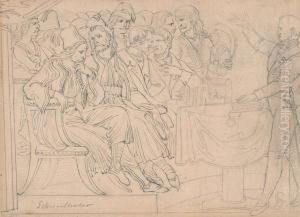Ludwig Von Schwanthaler Paintings
Ludwig Michael von Schwanthaler, renowned as one of the most prominent German sculptors of the 19th century, was born on August 26, 1802, in Munich, Bavaria. Hailing from a family with a rich artistic legacy, Schwanthaler was the nephew of the eminent sculptor Franz Jakob Schwanthaler, who significantly influenced his early development as an artist. Ludwig's father, Thomas Schwanthaler, was also a well-respected sculptor, ensuring that Ludwig was immersed in the world of art from a very young age.
Schwanthaler's formal training in the arts commenced at the Academy of Fine Arts Munich, where he studied under the tutelage of renowned classicist sculptor Konrad Eberhard. His education was steeped in the neoclassical tradition, which greatly shaped his stylistic leanings and artistic output. Schwanthaler's burgeoning talent did not go unnoticed, and he quickly garnered attention for his sculptural works, which combined a mastery of classical form with a sentimental and romantic expressiveness.
In 1826, Schwanthaler embarked on an influential study trip to Rome, which was then the epicenter of artistic learning and practice. This experience further solidified his neoclassical style and expanded his repertoire. Upon returning to Munich, he became a central figure in the city's cultural life, contributing significantly to the artistic endeavors patronized by King Ludwig I of Bavaria, who was an ardent supporter of the arts and aimed to transform Munich into a 'German Athens.'
One of Schwanthaler's most celebrated works is the Ruhmeshalle (Hall of Fame) with the Bavaria statue, a colossal bronze female figure personifying the Bavarian nation, which was completed posthumously. He also created the designs for the friezes of the Walhalla temple and numerous other public monuments and sculptures that adorn the city of Munich and other parts of Bavaria.
Despite his success, Schwanthaler struggled with health issues throughout his life, and his prolific career was cut short when he died on November 14, 1848, at the age of 46. His legacy, however, endures through his numerous sculptures that still stand today, marking him as a significant contributor to the 19th-century neoclassical movement in Germany.
